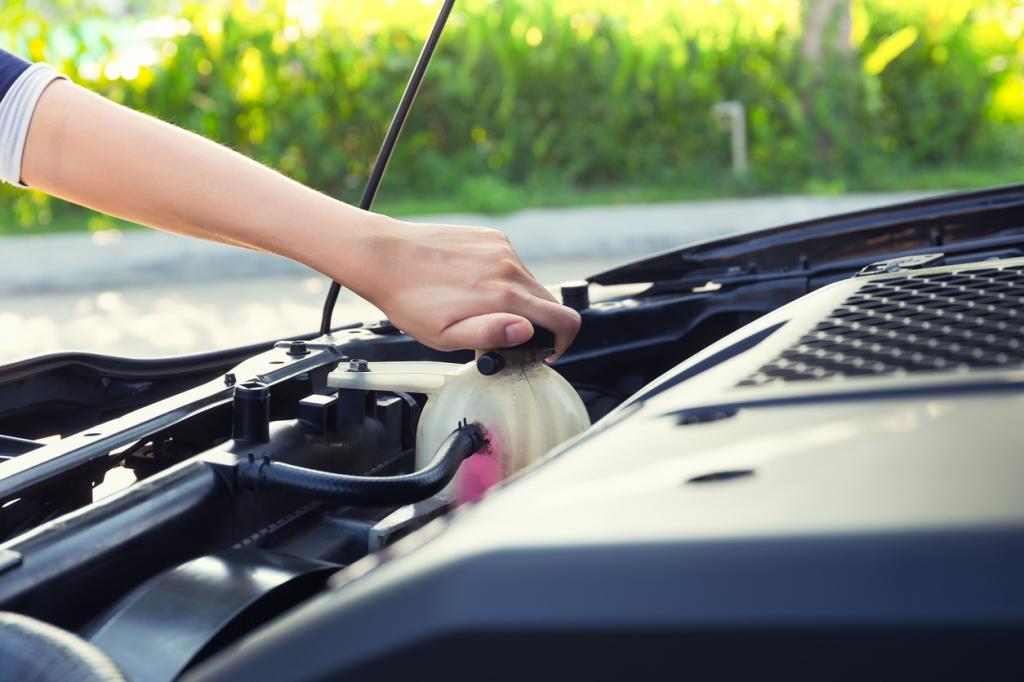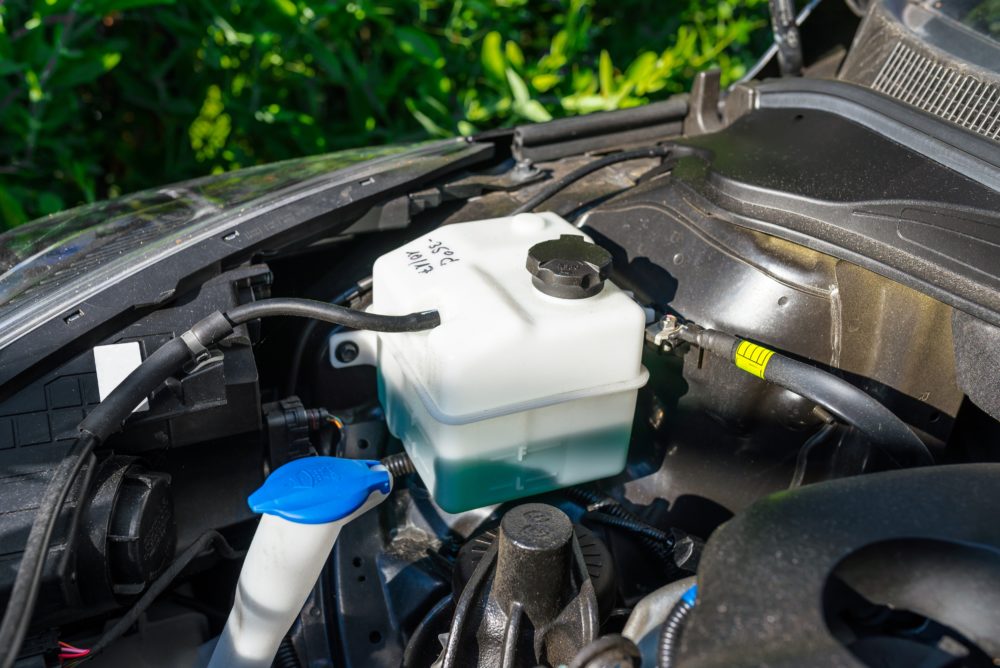If one unfortunate morning, you see a blue liquid flowing from the bottom of your car, deposited on the ground, it is an alarming situation. Maybe your engine coolant has leaked. There are many reasons for this leak. And by the experience of repairing hundreds of cases, we will reveal to you the specific causes and how to find a coolant leak and ways to fix it.
Contents
What is The Car Coolant?
Automotive engine coolant is a specialized solution that maintains the ideal temperature for car engines to operate. With the exclusive formula of the manufacturers, the coolant will absorb the heat radiated from the engine, increasing the boiling point of the water and reducing the freezing point.
The role and use of car coolant
Thanks to this coolant, the car motor can work better and becomes more durable over time. If the coolant tank is empty, the car engine will overheat, leading to an explosion. So car coolant is a solution that car drivers need to check and inspect regularly.
During car operation, the fuel is burned in the cylinder, causing a large amount of heat to be released. And when the heat is too high, the engine strength will decrease, leading to damage to the details and thermal stress. At the same time, the lubricating effect of the oil will be reduced. Since then, the friction of the engine’s surface will increase at the same time, affecting the performance and life of the car engine.
More dangerous, when the oil reaches a temperature of 200-300 degrees Celsius, it will spontaneously ignite, potentially causing the risk of fire and explosion. Therefore, car coolant acts as a bridge to transfer heat from the engine body to the cooling tank to help the car engine temperature not exceed the allowable limit.
In addition, one of the indispensable roles of engine coolant is to lubricate and prevent the corrosion of components. If it’s not engine coolant but normal filtered water, your car’s engine will quickly “go” because of the corrosion.
So undoubtedly, the coolant leaking over time will cause severe consequences. Insufficient cooling water or low coolant will directly affect the engine’s ability to cool down. The motor working in a prolonged high-temperature condition with leaking coolant may lead to many serious consequences which may be unwarned.

Signs You May Have A Coolant Leaking
If there is a coolant leak within your auto system, you may immediately notice these signs as they are quite visible and easy to realize.
- The sweet smell/aroma comes from the vehicle after you drive it or show up around the car. You may also smell it from behind the wheel.
- Puddles under the car appear in colors as orange, green, pink, or blue-green after you drive away from a parking spot. Explaining the colors, coolant makers usually use those dye colors to differentiate coolant from other fluids used in cars. Engine oil is gold/dark yellow or black (when it’s dirty), and dark red is for transmission fluid.
- The car becomes hot or overheated for no common reason you have checked.
With that said, below are 5 common places where you can find the coolant leak you may want to keep a close eye on, so let’s follow along.
How To Find A Coolant Leak?
To find the coolant leak, drive the car until the engine is warm. After that, park your car on clean and dry pavement or in a safe and clear driveway if possible.
Then, turn the car off and let it cool. Be cautious that when the car is warmed, the coolant will be hot and pressurized. Do not open the sump cap or radiator cap. And then we are all set under the hood.
After the car is cooling for 15 minutes, look under the car for any antifreeze-colored water. If there’s no fluid that you find smells like the coolant, get down on your knees to scan the underside of your car and see if you can see anything else is wet or dripping.
1. Radiator cracked/punctured/torn
The radiator is a part getting a lot of wear and tear due to the nature of its operation. Over time, radiators corrode. And this may be the common cause of the radiator being punctured, causing the cooling water to leak.
In addition, the gasket between the radiator and the reservoir can wear out, causing a leak. There may also be a leak coming from one of the pipes connected to the radiator. Over time, these tubes become brittle and break easily.
2. Coolant radiator cap
The cooling water tank cap is not only responsible for keeping the coolant from escaping, but also ensuring stable pressure inside. When the radiator cap works correctly, it creates a protective shield, keeping the radiator in good working order at the correct pressure.
However, over time, the radiator cap will wear out, unable to create as good protection as the original. From there, cooling water can leak outside. So the first spot you can check to find a coolant leak can be the coolant radiator cap.
3. Broken cylinder head cover gasket
You may not know that the head cover gasket is responsible for keeping the engine oil and the coolant separate. When a piece of pretzel goes under-performed, you may not even know what’s going on because a leak could be inside.
However, you may notice coolant in the engine oil or vice versa. You will also see the engine temperature begin to rise. Eventually, the coolant will leak outside the engine, indicating more severe problems.
4. Pump is broken
The water pump is responsible for circulating cooling water through the system and is monitored by a belt. This belt connects to the engine crankshaft, but this part can corrode and leak.
The water pump itself can also be affected by external influences leading to leaks. Either way, if the pump is not working properly, the coolant cannot move properly, which will cause the engine to overheat.
5. Auxiliary water tank for engine cooling is defective
In the car’s engine compartment, you will find an extra coolant tank. It is connected to the radiator by a flexible hose. Its main job is to provide coolant to the radiator when needed. However, time makes the auxiliary cooling water tank age, which can lead to cracking and it will begin to leak.
After checking every above part but still can’t find the leak, combined with the smell that appears strong inside your vehicle than outside, the problem could be inside the heater. Usually, car heaters use a small radiator core to warm the cabin. If the car mat is suddenly wet or the windows seem to fog up faster than usual, the heater core may be dealing with issues. Heater-core problems are quite hard to find and fix because it is a piece of the air conditioning system concealed by the dashboard. If that’s your facing case, unless you’re familiar with tools and fix-it-yourself projects, reach out for technician support.
>> Related post: Your Car Is Losing Coolant But No Leak: What Should You Do?
What Should You Do If You Can’t Find The Coolant Leaking Spot
Not finding the coolant leak in these above positions does not ensure that you do not have to face any hidden one. Once your engine has cooled down completely, check your coolant level to see if it is low. The coolant-level indicator is on the side of the translucent plastic tank, and its level should be between the min and max markings. If the tank is still full, the smell is probably not from a coolant leak.
On the other hand, if the tank’s level is below the minimum mark or it’s been dry for a while, you may have a problem.

How Long Can You Drive With a Coolant Leak?
Have you ever wondered how long you can drive with a coolant leak? If you are dealing with this issue, we suggest you find methods to fix it as soon as possible and avoid leaving it untouched or ignored. You should know that any problems related to the cooling system or coolant tank will not be fixed as self-healing methods and can even erode faster. Early signs of car coolant leakage are not hard to notice. So you always have to pay attention to the possible symptoms to avoid being pulled off on the road in the middle of nowhere.
If you believe your luck and have a just-found-out coolant leak in your car, driving your car for a few days may be bearable when topping off the coolant tank with pure water if it gets low.
However, it’s always ideal with the proper 50-50 ratio of coolant and water mix to fill your cooling system tank, most suitable in winter. If you only add water to a tank on a freezing winter night, it will soon turn to ice. And ice in any engine system is never a good sign. The expanded area that ice makes may blast the radiator, and brake hoses within the cooling system, crack a cylinder head or the engine block, then slowly damage your engine and car cooling system. In general, car coolant lowers its freezing point to around -35°F to -36°F to avoid damage caused by frozen water. So, have your car inspected and fixed soon to prevent more serious and expensive engine damage.
>> See more: Getting Smells of Antifreeze? What to Do?
Note that ethylene glycol coolant is poisonous if accidentally ingested. This hazard can happen at any time, in which the highest risks belong to children and pets because its sweet smell can draw attraction to under-conscious-about-it individuals. So always keep the solution out of your children’s reach and wear protection items when dealing with it.
Wrapping Up
Above are the most detailed instructions on how to find a coolant leak we want to share with you. Hopefully, the above sharing will make it easier for you to check and maintain your coolant tank, your cooling system, and your car engine on the whole. But if you can not inspect it yourself, you can bring the car to a professional workshop.
For more



